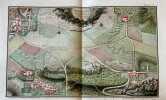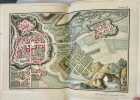7 books for « fosse charles louis d... »Edit
-
Topics
Army (1)
Binding w/arms (1)
Economics (1)
First edition (1)
Military arts (3)
Various (1)
-
Countries
Denmark (3)
France (4)
-
Syndicate
ILAB (7)
SLAM (4)
Idées d’un militaire pour la disposition des troupes confiées aux jeunes officiers dans la défense et l’attaque des petits postes.
1783 Paris. Didot l’ainé chez Alexandre Jombert. 1783. 2 parties en 1 volume in-4, demi-basane noire moderne grossière. (7) ff. ; 116 pp. ; 60 pp. ; 11 planches.
Edition originale illustrée in fine de 11 cartes topographiques dépliantes en couleurs dessinées par Fossé et gravées par Louis-Marin Bonnet, contrecollées sur leur page de légende de manière à voir les 2 simultanément. Blason du duc du châtelet gravé en couleurs en tête de dédicace.Traité de stratégie de défense et d’attaque militaire se basant sur plusieurs situations variant en fonction des postes occupés (fermes, bois, plaine, gué, château et même cimetière!). Il est suivi de : Précis pour servir à représenter les plans militaires expliquant les techniques de tracé et l’emploi des couleurs selon la nature du paysage représenté, et s’achève sur la construction de la perspective militaire.Ouvrage remarquable par ses 11 plans gravés illustrant pour la première fois cette nouvelle technique d’impression en couleurs élaborée par Bonnet et décrite par Fossé en 2ème partie d’ouvrage. Elle perfectionne le procédé de la gravure à la manière de crayon en élargissant le panel des couleurs et en améliorant la qualité d’impression pour un rendu de haute qualité. Ex-libris manuscrit sur la première garde en partie effacé.Infimes rousseurs. Reliure légèrement frottée.Brunet II, 1354.
Idées d’un militaire pour la disposition des troupes confiées aux jeunes officiers dans la défense et l’attaque des petits postes.
1783 Paris. Didot l’ainé chez Alexandre Jombert. 1783. 2 parties en 1 volume in-4, demi-veau, dos lisse orné, infime frottement au second plat. (6) ff. ; 116 pp. ; 60 pp. ; 11 planches à double page en couleurs, avec 1 feuillet d'explication pour chaque; (1) f.
Edition originale illustrée in fine de 11 cartes topographiques dépliantes en couleurs dessinées par Fossé et gravées par Louis-Marin Bonnet. Traité de stratégie de défense et d’attaque militaire se basant sur plusieurs situations variant en fonction des postes occupés (fermes, bois, plaine, gué, château et même cimetière!). La seconde partie est constituée d'un : Précis pour servir à représenter les plans militaires. Il explique les techniques de tracé et l’emploi des couleurs selon la nature du paysage représenté, et s’achève sur la construction de la perspective militaire.Ouvrage remarquable par ses 11 plans gravés illustrant pour la première fois cette nouvelle technique d’impression en couleurs élaborée par Bonnet et décrite par Fossé en 2ème partie d’ouvrage. Elle perfectionne le procédé de la gravure à la manière de crayon en élargissant le panel des couleurs et en améliorant la qualité d’impression pour un rendu de haute qualité. Ex-libris Baron de Mackau.Brunet II, 1354.
Idées d'un Militaire pour la Disposition des Troupes confiées jeunes officiers dans la Défense et l'Attaque des Petits Postes. Dédié a M. le Duc du Chatelet. - [THE FIRST BOOK SUCCESSFULLY PRINTED WITH COLOURS]
Paris, de l'Imprimerie de Franc. Amb. Didot l'Ainé. Chez Alexandre Jombert, jeune, 1783. 4to. Nice contemp. red hmorocco with 5 raised bands and richly gilt compartments. Corners restored. Light scratching to boards.Stamps on htitle. A small stamp on titlepage.. (14), 116, 60 pp. + 11 leaves of plate-description, on which the plates are mounted at top, 2 pp. of approbation and privilege. On thick, good paper. A very nice, crisp and complete copy w. clear colours. Apart from the stamps on the htitle, a fine, large and clean copy. The dedication-leaf (A monsieur Le Duc du Chatelet) with his large engraved coat of arms handcoloured.
First edition of the main work of the French military engineer Fossé (1734 - 1812). This military work, divided into two sections, one dealing with military strategies concerning defending and attacking, the other dealing with military plans and how to construct maps, is especially renowned for the extraordinary coloured plates by LOUIS MARION BONNET.The plates, depicting plans and maps, show for one of the first times the perfection of the illustrating-process called the CRAYON MANNER adapted to colour-printing, and the work is probably the first book printed using this technique. The technique of printing with colour only began about 20 years before this work was issued during the first many years, though, many attempts failed, and it wasn't till Bonnet came up with the coloured crayon manner that it was really a success. Bonnet increased the number of plates in order to make it possible to print with several colours. The crayon manner became a great success in Europe and is a fore-runner of the lithography-process. All the plates are signed by Bonnet and are in at least four colours.This work is also renowned for its splendid typography that later on became known as the Didot-style. Graesse II:620. Brunet II:1354.
Idées d'un Militaire pour la Disposition des Troupes confiées jeunes officiers dans la Défense et l'Attaque des Petits Postes. Dédié a M. le Duc du Chatelet. - [THE FIRST BOOK SUCCESSFULLY PRINTED WITH COLOURS]
Paris, de l'Imprimerie de Franc. Amb. Didot l'Ainé. Chez Alexandre Jombert, jeune, 1783. 4to. Cont. full mottled calf with gilt red title-label to richly gilt back. Neat professinal repairs to back, hinges and boards. Title-page and first few leaves with a bit of brownspotting, otherwise internally very nice and clean with only occasional scattered minor brownspotting. Woodcut printer's device to title-page, large coloured vignette to dedication-leaf (etched and colour printed), 11 coloured plates, 10 on which folded - all plates etched and colour-printed. Library-stamp on t-p. (14), 116, 60 pp. + 11 leaves of plate-description, on which the plates are mounted at top, 2 pp. of approbation and privilege. On thick, good paper. A very nice, crisp and complete copy w. clear colours.
First edition of the main work of the French military engineer Fossé (1734 - 1812). This military work, divided into two sections, one dealing with military strategies concerning defending and attacking, the other dealing with military plans and how to construct maps, is especially renowned for the extraordinary coloured plates by LOUIS MARION BONNET.The plates, depicting plans and maps, show for one of the first times the perfection of the illustrating-process called the CRAYON MANNER adapted to colour-printing, and the work is probably the first book printed using this technique. The technique of printing with colour only began about 20 years before this work was issued during the first many years, though, many attempts failed, and it wasn't till Bonnet came up with the coloured crayon manner that it was really a success. Bonnet increased the number of plates in order to make it possible to print with several colours. The crayon manner became a great success in Europe and is a fore-runner of the lithography-process. All the plates are signed by Bonnet and are in at least four colours.This work is also renowned for its splendid typography that later on became known as the Didot-style. Graesse II:620. Brunet II:1354.
Idées d'un militaire pour la disposition des troupes confiées aux jeunes officiers. dans la défense et l'attaque des petits postes (...). Dédié à M. le Duc du Châtelet
Paris, Alexandre Jombert Jeune (de l'Imprimerie de François Ambroise Didot l'aîné), 1783 2 parties en un vol. in-4, [7] ff. n. ch. (faux-titre, titre, dédicace, table), 116-60 pp., un feuillet non chiffré (approbation et privilège), avec une belle vignette en-tête héraldique en couleurs, et 11 très belles planches dépliantes insérées sur le mode de collettes summitales, très finement gravées et colorisées par Louis-Martin Bonnet, sous serpentes, légendées chacune d'un feuillet de texte ; exemplaire dans lequel il y a interversion alternante des ff. 33-34 à 39-40 de la première partie, sans manque, veau fauve écaille, dos lisse orné, tranches marbrées (reliure de l'époque). Mors restaurés.
Unique édition de ce livre important et rare.Il est divisé en deux parties : 1. Le texte sur la défense et l'attaque des petits postes. - 2. Un important "Précis pour servir à représenter les plans militaires", développant surtout l'emploi des couleurs pour le lavis des plans, et se plaçant dans la ligne de Buchotte. Il systématise les usages et les techniques en vigueur depuis le milieu du XVIIIe siècle dans la réalisation des plans militaires en couleurs, que l'on retrouve dans de nombreux manuscrits de l'époque.La seconde partie est illustrée de 11 superbes exemples de plans militaires au lavis, admirablement gravés et soigneusement coloriés par Louis-Marin Bonnet (1736-1793), inventeur du procédé expliqué dans le texte. On joint une pièce manuscrite complétant les données de la seconde partie sur l'utilisation des couleurs : Mélange des couleurs propres au lavis des plans (4 pp. n. ch.).Très bon exemplaire. - - VENTE PAR CORRESPONDANCE UNIQUEMENT


Phone number : 06 46 54 64 48
In Erfahrung gegründete Gedanken vom Gebrauch der Mannschaften, Die jungen Officieren anbetrauet werden bey Angriff und Vertheidigung Kleiner Posten. Aus dem Französischen übersetzt und herausgegeben von heinrich Johannes Krebs.
Copenhagen, Möller und Sohn, 1789. 4to. Cont. full marbled calf. Gilt back and gilt borders on covers. Back slightly rubbed. Small loss of leather at bottom of frontcover. Stamp on title and old owners name. (12),183 pp. and 11 large folded engraved maps and plans. Printed on good paper, internbally clean.
First German edition. A translation of the author's ""Idées d'un militaire pour la Disposition des Troupes...Paris, 1783"". - Klaus Jordan No. 1253.
Idées d'un militaire pour la disposition des troupes confiées aux jeunes officiers dans la défense et l'attaque des petits postes
Chez Alexandre Jombert | à Paris 1783 | 21 x 27.50 cm | relié
Edition originale illustrée d'une vignette en tête de la dédicace en couleurs et 11 plans dépliants dessinés par Fossé et gravés en couleurs par Louis Marin Bonnet. Impression sur papier fort. Reliure usagée en pleine basane fauve d'époque. Dos à nerfs orné. Pièce de titre en maroquin beige. Coiffes arrachées. Mors ouverts en queue et tête. Frottemenets et épidermures. Coins rognés et dénudés. Large manque au faux-titre. Traité de stratégie de défense et d'attaque militaire. Il s'appuie sur des exemples concrets situés dans une plaine, à un gué, sur un pont, dans un château ou un village. L'ouvrage s'achève sur un Précis pour servir à représenter les plans militaires, traitant des couleurs propre au lavis des plans, leur emploi, et sur un court traité sur la Construction de la perspective militaire. Le livre est surtout remarquable par son illustration. Louis Marin Bonnet porta à la perfection le procédé de la gravure à la manière de crayon dans les années 1770. Les consignes données par Fossé pour les lavis sont prises en compte pour l'impression en couleurs de ces estampes. Bonnet s'attribue l'invention en se qualifiant de "premier graveur de ce genre" ; en fait, il améliora le procédé créé par son maître Demarteau. Néanmoins, Bonnet mis au pooint l'impression aux deux crayons (le noir rehaussé de blanc) et l'impression en manière de miniature ou pastel, se portant ainsi concurrent direct des Gautier-Dagoty. - Photographies et détails sur www.Edition-Originale.com -


Phone number : 01 56 08 08 85
 Write to the booksellers
Write to the booksellers








